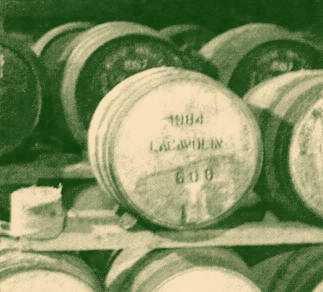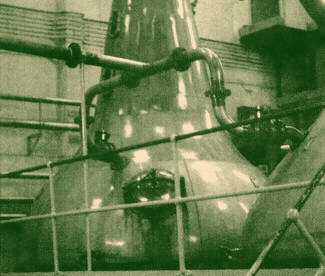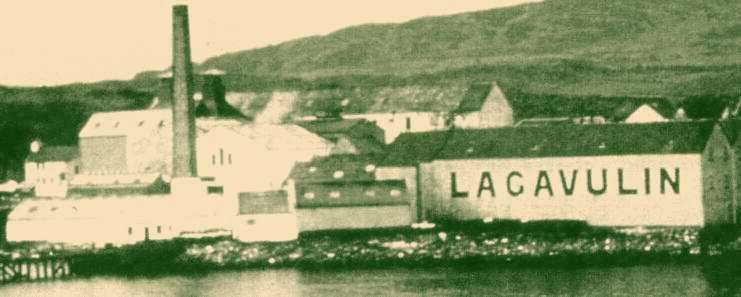Lagavulin
A taste of the tangle ofthe isles
There is a scattering of houses on the southernshore of Islay know as "Lagganmhoullin". The Englishtranslation from the Gaelic is "the mill in thehollow". This gives a strangely tranquil impression of thiswild and very windswept, often bleak spot on the southern shoreof Islay. A spot washed and battered by the prevailingsouth-westerlies which have had the full width of the Atlantic inwhich to gather their wrath before venting it upon the island.Alfred Barnard described the environs of Lagavulin distillery onhis visit in 1885: "The works are built at the head of aminiature bay, around which rocks of fantastic shape riseabruptly from the sea; in some places detached masses have fallenin such a position that they rise from the sea like weirdmonsters of the deep".
 In 1156 a great sea battle was foughtoff the west coast of Islay. Somerled, who became the first Lordof the Isles, wrested control of the Inner Hebrides from Godredof Man and Lagavulin Bay was the shelter he sought in victory.Two generations later, Somerled's grandson, Donald I, builtDunyvaig Castle to protect his fleet and the remains watch overthe distillery today. It was also from here that 1800 Ilich(Islaymen), tacksmen of Angus Og, the then Lord of the Isles, setsail in 1314 to support Bruce at Bannockburn.
In 1156 a great sea battle was foughtoff the west coast of Islay. Somerled, who became the first Lordof the Isles, wrested control of the Inner Hebrides from Godredof Man and Lagavulin Bay was the shelter he sought in victory.Two generations later, Somerled's grandson, Donald I, builtDunyvaig Castle to protect his fleet and the remains watch overthe distillery today. It was also from here that 1800 Ilich(Islaymen), tacksmen of Angus Og, the then Lord of the Isles, setsail in 1314 to support Bruce at Bannockburn.
Due to the loyalty of the Campbells to the crown after the Actof Union, and the remoteness of the isles from Edinburgh, Islayand Jura were exempted from the control of the Board of Excisebetween 1707 and 1823. The lairds were given the right to collectExcise duties on the islands - and allowed to keep any moniesgathered. The result was that taxes were levied on very fewoccasions.
Thus distilling blossomed on Islay and, in 1742, there were 10bothies operating around Lagavulin Bay. By the end of the 18thcentury, these had merged to form today's distillery.
Islay's distilleries' very existence is inextricably linkedwith Poseidon's kingdom. The barley is carried in by sea and themake is taken out by sea; chust like Para Handy, Lagavulin hadits own Clyde puffer, the S.S. Pibroch which plied betweenGlasgow and Islay from 1924 to 1956; the distilleries'white-washed walls, being situated on the shoreline, areregularly washed clean by the sea, as it forces its way throughair-bricks and windows to form puddles of salt-water on thewarehouses' earthen floors; the peat growing around Lagavulin hasa high moss content and soaks up the flavours of the sea whilethe air is filled with its aromas and the cries of its birds.
 The use of peat is endemicin the north-western highlands and islands of Scotland andparticularly so on Islay, where there is no othernaturally-occurring combustible material with which to dry themalt. As, historically, the malt would have been dried using onlypeat, Lagavulin's make of the last century was most probably evenmore smokily pungent than it is today.
The use of peat is endemicin the north-western highlands and islands of Scotland andparticularly so on Islay, where there is no othernaturally-occurring combustible material with which to dry themalt. As, historically, the malt would have been dried using onlypeat, Lagavulin's make of the last century was most probably evenmore smokily pungent than it is today.
Lagavulin no longer operates its own floor maltings, insteadmaking use of United Distillers' maltings at Port Ellen. There,the malt is produced to Lagavulin's own particular"recipe": a specific time dried by gas, followed by anexact time dried by the island's peat. The computer-controlleddrum maltings give a high degree of precision and ensure thatexactly the same degree of phenol absorption is achieved eachtime. This gives the distiller a more consistent malt. Theisland's water supplies are also impregnated by the peat makingit the colour of the whiskies and causing tourists to commentthat their bath water is dirty before they step into it.Lagavulin's water is no different, coming as it does from thenearby Lochan Sholum, which is situated at a height of 200 metresabove sea level. This soft water flows two and a half miles,through the peat, down the hillside to the distillery.
The casks ageing at Lagavulin are expirating every second ofthe day and as the spirit softens and matures, it loses alcoholand volume. The vacuity within the cask, while full of spirit andwhisky aromas also inhales aromas from the cask's surroundings.In the case of Lagavulin, the cask absorbs aromas of seaweed,fish, ozone and the bracing influence of Lagavulin's sea-air; thespirit in turn absorbs elements of these characteristics.
 The distillery's ProductionManager is Donnie MacKinnon, a former rugby player for the Islayrugby team with a beard to help insulate him against thesouth-westerlies. An Ileach born and bred, he has done most jobsat Lagavulin in the past 34 years (as well as being a pantry boyon the Caledonian-MacBrayne ferry which plies between themainland and Islay when he first left school) and has seen theindustry change and the size of its workforce fall. He talks withregret about some of the "progress", but states proudlythat "the quality control is now much better now than it hasever been."
The distillery's ProductionManager is Donnie MacKinnon, a former rugby player for the Islayrugby team with a beard to help insulate him against thesouth-westerlies. An Ileach born and bred, he has done most jobsat Lagavulin in the past 34 years (as well as being a pantry boyon the Caledonian-MacBrayne ferry which plies between themainland and Islay when he first left school) and has seen theindustry change and the size of its workforce fall. He talks withregret about some of the "progress", but states proudlythat "the quality control is now much better now than it hasever been."
Donnie's stills are very unusual in that they greatly resemblea totally spherical globe onion, from the bulbous base to thequite high apex and their narrow, steeply-sloping lye pipes. Thespirit they produce has been likened to "a Gaelic hymn tothe glorification of peat". Lagavulin is always among thebiggest, most full-bodied of malts, the peat reek in the spirit'syouth resembling burnt mahogany, with the burnt heather rootscharacter coming through as it matures. The sea's influence isalmost restrained, hidden by the peat, with just a touch of salton the lips and a little prevalent sweetness which is furtherbrought out if aged in a sherry cask.
John Lamond

If you have comments about thissite, please contact the webmaster. Unless otherwise noted, all information in this siteŠ The Scotch Malt Whisky Society, Edinburgh, Scotland, 1997.
 In 1156 a great sea battle was foughtoff the west coast of Islay. Somerled, who became the first Lordof the Isles, wrested control of the Inner Hebrides from Godredof Man and Lagavulin Bay was the shelter he sought in victory.Two generations later, Somerled's grandson, Donald I, builtDunyvaig Castle to protect his fleet and the remains watch overthe distillery today. It was also from here that 1800 Ilich(Islaymen), tacksmen of Angus Og, the then Lord of the Isles, setsail in 1314 to support Bruce at Bannockburn.
In 1156 a great sea battle was foughtoff the west coast of Islay. Somerled, who became the first Lordof the Isles, wrested control of the Inner Hebrides from Godredof Man and Lagavulin Bay was the shelter he sought in victory.Two generations later, Somerled's grandson, Donald I, builtDunyvaig Castle to protect his fleet and the remains watch overthe distillery today. It was also from here that 1800 Ilich(Islaymen), tacksmen of Angus Og, the then Lord of the Isles, setsail in 1314 to support Bruce at Bannockburn.  The use of peat is endemicin the north-western highlands and islands of Scotland andparticularly so on Islay, where there is no othernaturally-occurring combustible material with which to dry themalt. As, historically, the malt would have been dried using onlypeat, Lagavulin's make of the last century was most probably evenmore smokily pungent than it is today.
The use of peat is endemicin the north-western highlands and islands of Scotland andparticularly so on Islay, where there is no othernaturally-occurring combustible material with which to dry themalt. As, historically, the malt would have been dried using onlypeat, Lagavulin's make of the last century was most probably evenmore smokily pungent than it is today.  The distillery's ProductionManager is Donnie MacKinnon, a former rugby player for the Islayrugby team with a beard to help insulate him against thesouth-westerlies. An Ileach born and bred, he has done most jobsat Lagavulin in the past 34 years (as well as being a pantry boyon the Caledonian-MacBrayne ferry which plies between themainland and Islay when he first left school) and has seen theindustry change and the size of its workforce fall. He talks withregret about some of the "progress", but states proudlythat "the quality control is now much better now than it hasever been."
The distillery's ProductionManager is Donnie MacKinnon, a former rugby player for the Islayrugby team with a beard to help insulate him against thesouth-westerlies. An Ileach born and bred, he has done most jobsat Lagavulin in the past 34 years (as well as being a pantry boyon the Caledonian-MacBrayne ferry which plies between themainland and Islay when he first left school) and has seen theindustry change and the size of its workforce fall. He talks withregret about some of the "progress", but states proudlythat "the quality control is now much better now than it hasever been." 